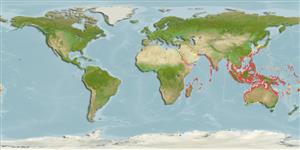Common names from other countries
Classification / Names / Names
Populärnamn | synonymer | Catalog of Fishes (gen., sp.) | ITIS | CoL | WoRMS
Environment: milieu / climate zone / depth range / distribution range
Ekologi
; djupintervall 0 - 30 m (Ref. 348), usually 0 - 25 m (Ref. 75831). Tropical
Indo-Pacific: from East Africa, to Melanesia; north to Japan and south to Queensland and Western Australia.
Length at first maturity / Size / Vikt / Age
Maturity: Lm ? range ? - ? cm Max length : 14.0 cm SHL hane/ej könsbestämd; (Ref. 348); common length : 9.5 cm SHL hane/ej könsbestämd; (Ref. 348)
Occasionally used for food by coastal populations, this species is nowadays mainly collected for its beautiful shell (Ref. 348). Found in intertidal areas on rocks (Ref. 75831).
Life cycle and mating behavior
Könsmognad | Reproduktion | Lek | Ägg | Fecundity | Larver
Members of the class Bivalvia are mostly gonochoric, some are protandric hermaphrodites. Life cycle: Embryos develop into free-swimming trocophore larvae, succeeded by the bivalve veliger, resembling a miniature clam.
Poutiers, J.M. 1998. (Ref. 348)
IUCN Red List Status (Ref. 130435)
CITES status (Ref. 108899)
Not Evaluated
Not Evaluated
Threat to humans
Harmless
Human uses
| FishSource |
Verktyg
Ytterligare information
Age/SizeTillväxtLength-weightLength-lengthMorfologiLarverAbundans
Internet-källor
Estimates based on models
Preferred temperature
(Ref.
115969): 24.4 - 29.1, mean 28 (based on 1424 cells).
Vulnerability
Low vulnerability (10 of 100).
Price category
Unknown.
